deadmonton 2006 - other police matters
the disappearance of robert barrington leigh
For nine days in August 2006 the story of Robert Barrington Leigh's disappearance led local newscasts and was a frequent topic of conversation around Edmonton water coolers and coffee bars.
How did a bright young math whiz vanish in a river valley full of festival-goers less than a kilometre from his family home?
The disappearance of Robert Barrington Leigh was also the story of a resourceful and loving family who opened their quest to public concern. They were rewarded with an outpouring of community support and volunteerism that has made Edmonton famous.
What the Barrington Leigh family was not rewarded with was a happy ending to their ordeal.
The body of their son and brother was found in the North Saskatchewan River across from Gallagher Park -- the site of the Edmonton Folk Music Festival where Robert was headed the night he disappeared.
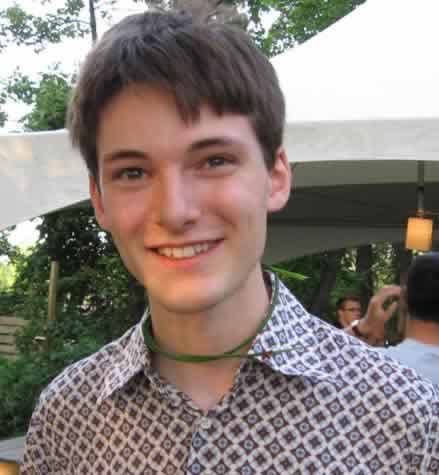 |
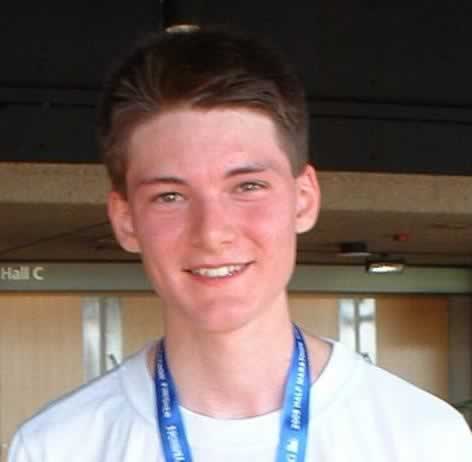 |
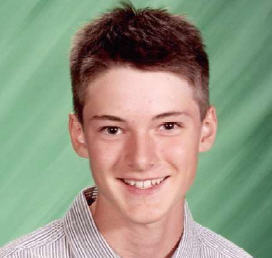 |
20-year-old Robert Barrington Leigh was last seen at about 10:30 p.m. on Sunday, August 13th, 2006 heading on his bike to the Edmonton Folk Music Festival in Gallagher Park.
Barrington Leigh was described as 6-feet tall, slim (weighing about 150 lbs) with short brown hair and hazel eyes.
He was wearing an olive-coloured Mountain Equipment Co-op fleece jacket, a short-sleeved shirt, khaki-coloured shorts, brown leather shoes, and was carrying a MEC backpack, blue with purple trim.
Barrington Leigh was riding a blue Raleigh "Cliffhanger" bike (mountain frame with road tires) with the seat post in a high position. His bike helmet was blue in colour.
He prepared a mushroom Parmesan risotto for his family the night he disappeared.
“He hadn't told me how much cooking he'd been doing,” his mother, Iris, said.
“It was excellent.”
Later that night, he waved goodbye to his mother, who was sitting on the couch in the family room watching television. “It was quite an ordinary day. I said ‘bye' and that was it.”
It was the last time his family saw him alive.
The Barrington Leigh family said Robert's sudden disappearance was very much out of character.
Cellphone records indicated he text-messaged his girlfriend, Lucy Zhang -- who was studying in Italy, at about 11:30 saying he wouldn't be calling her.
Robert cycled from his family's home at 9820 85 Avenue to the festival intending to meet friends. He never met his friends and he never returned home. His bank account and credit card was not used after he went missing on that summer night.
Not waiting for Edmonton police to issue an alert, on August 15th the family appealed to media to bring the matter to public attention.
"I fear that something bad has happened to him because it's so out of character for him to disappear," said Robert 's mother, Iris.
"I don't have the best feeling about the situation," said his father, John Barrington Leigh. "He's a gifted mathematician. He's very academic, very straight and narrow. Bad things happen to nice guys. I suspect foul play. That's my instinct."
On August 16th about 80 friends, neighbours and former teachers began a search of Mill Creek Ravine and other areas of the river valley in an attempt to find Robert.
Some scoured the river's banks by canoe as the Edmonton police Air-1 helicopter flew overhead.
Police appointed a search manager and at first relied on patrol members to keep an eye out for anything related to Robert's disappearance.
The Barrington Leigh family household was transformed into a buzzing, 24-hour emergency call centre.
Robert's siblings -- Christopher, 32, and Rosalind, 34 -- came in from Vancouver to create a website, www.findrobert.ca, co-ordinate search efforts and help distribute posters that soon appeared around the city and in surrounding communities.
By August 17th, the number of volunteers joining in the search was well over one hundred.
One volunteer, Janet Hardy, told media, "Hopefully he's just been in a (bicycle) accident in the ravine somewhere, or maybe he hit his head and has amnesia."
The Edmonton police Air-1 helicopter searched the Mill Creek Ravine again without result.
"We haven't had a single tip," Hardy said.
A police spokesman said missing persons detectives were expected to pick up the case when they return from vacation in the week following.
"We have no evidence to indicate foul play," he said. "Public help in this type of case is paramount (to helping solve it)."
The investigation at the time was being handled by south-side officers and a vice detective.
However, all that changed during the afternoon of the 17th when police set up a command post in the parking lot of the Mill Creek Pool.
Over a dozen police officers, Alberta Search and Rescue volunteers and four search dogs began combing the wooded area of Mill Creek Ravine.
The late arrival of the heightened police involvement was questioned by some in the media.
Police said they stepped up the search because Robert hadn’t used his cell phone or credit cards since the night he disappeared, suggesting he may have come to harm.
“There has been no activity on his cell phone or his credit cards since he disappeared Sunday night,” said a police spokesman. “That’s why we have we are investigating -— why we have stepped it up a notch.”
It was later learned police were hampered by privacy act laws that prevented them from accessing cell phone and bank records that confirmed earlier family statements of non-use.
Edmonton police deal with 7,000 missing persons cases a year, and the spokesman said if officers find nothing, they'll call the search off within a day with the case remaining an active investigation.
The spokesman credited Barrington Leigh's "astute" family with helping to bring attention to the case but said each of the missing persons reports received by the department is treated the same.
"What we're doing is going through what we normally do."

However, Barrington Leigh's older brother, Christopher, felt media attention was a primary motivator for the police to elevate their participation.
"The large media attention, hand-in-hand with the outpouring of community support is absolutely what gets the attention of the police," Christopher said.
Police later insisted that media attention played no part in their reaction to the 20-year-old's disappearance, citing that missing persons cases are detailed in press releases sent out to media [including The Last Link on the Left].
The police spokesman said the releases are often ignored completely but, "For whatever reason, this one has captured the media attention. [The Barrington Leighs] might have more [resources at their disposal] than another family."
"Obviously this is a very special individual, and he's loved by family, and obviously they've been able to reach out through the media and connect with people, often strangers who just want to help," the spokesman said.
As the search continued, the Edmonton Sun carried a story that revealed that John Barrington Leigh had been at the centre of a similar family crisis nearly two decades ago.
The retired physicist said, "I've been through this before."
He was referring to an incident in 1989 when a family member, travelling in Athens, Greece, was attacked by three men armed with stones.
She suffered a brain injury and Barrington Leigh was forced to track down information about her and put together a plan to ensure her return home after which she recovered fully.
"You go into a different mode," said Barrington Leigh, who didn't go into much detail about the 17-year-old incident.
"The best position is to be the point person. I was the least hit by that (incident)."
About the disappearance of his son, John said, "It's completely and utterly weird. I'm beginning to get anxious there might not be a resolution."
Late on August 18th police announced they called off their ground search.
“It is a bit disappointing,” said Barrington Leigh’s older sister, Rosalind. "But I understand their point of view.”
"With no new leads, there’s nothing more they can do on the ground," said a police spokesman, adding it was a “tough decision” to call it quits.
“Until you get other information to lead you in another direction, I mean, we could be scouring the whole city. That’s just not possible.”
The spokesman added, “This is still very much an active and open file,” stating police had received “numerous” tips.
The Barrington Leigh family expanded their search making contact with bus and taxi drivers. However, with his passport at home and limited cash in his possession, the family figured Robert couldn't have gotten far.
Through their web site, the family asked to speak to anyone who attended a party held in Queen Elizabeth Park on the night Robert disappeared.
It was later determined that the cell phone text message he sent to his girlfriend was relayed through a single tower near the park. As the signal was not redundantly received on a second tower, the exact location where the call was placed could not be triangulated.
Global Edmonton reported that Robert told Lucy Zhang that he was in Queen Elizabeth Park heading towards the folk music festival and that he would not be able to call her later. Lucy added in another report that he wished her luck on her mid-term exams.
"He was very happy the last few times I talked to him," Zhang said. "There was nothing weird about his message."
A family friend helping with the search effort noted that Robert must have been off his bicycle to type a text message and could have been observed.
Nearly a week after Robert disappeared, Christopher Barrington Leigh told the Edmonton Sun there was a growing possibility that Robert was on a self-imposed "math retreat" and didn't want to be found. Christopher also appealed to his brother.
"It's as likely that Robert is in fact out hiding somewhere as that we are looking for a body somewhere in the river valley. This is a clever individual. If he wanted to hide himself he could," he said.
"Maybe he's too embarrassed to come back because we've made such a fuss. Robert, that's OK. Please come home. We want to see you."
Christopher admitted running away would be totally out of character for his brother, who seemingly had no apparent reason to want to duck out of society.
"This was a happy man with a spectacular future," added Christopher.
"I'm sort of feeling a little more optimistic after we had good long chats with the [missing persons] detectives. We've come to realise again how open the possibilities are."
On August 20th the Barrington Leigh family announced it had posted a $5,000 reward for information leading to Robert's location.
“After a week with no clues, we just want to put some pressure on people who know something but haven’t come forward,” Christopher said.
The river valley search continued with volunteers covering ground as far downstream as Gold Bar Park. A remote controlled plane was provided to take ariel photographs while some searchers kayaked along the river.
On the morning of August 22nd, Edmontonians following news of Robert's disappearance read of how his family were scouring the family computer in hopes of finding clues as to his whereabouts.
"They're looking at all his accounts on the computer, there might be an e-mail there or something to give us a clue where he is," Robert's sister Rosalind said.
Rosalind also took exception to comments of Stanford professor Keith Devlin who was quoted as saying, "Many mathematicians are a bit bonkers."
"Robert is very clever, but he was just starting to come out of his shell and explore different things. He was excited about his life and was beginning to socialise more, not less.
"But I do accept that some people with that kind of mind may be prone to eccentricity."
Devlin is heard on National Public Radio in the United States where he is known as the "Math Guy."
By the time most in the Alberta capital had finished or returned from lunch, news came that a body had been found in the North Saskatchewan River.
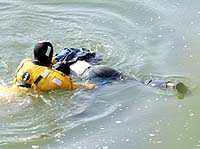
At about 11:00 a.m. Edmonton firefighters in wetsuits fought fast-flowing currents as they pulled a body from the river near 92nd Street and 99th Avenue.
The body was found trapped by deadfall at the side of the river across from Gallagher Park, the site of the Edmonton Folk Music Festival.
Police said the body was found by a contract employee manning a City of Edmonton Water and Sanitation jet boat while inspecting drainage pipes along the riverbank.
Alan Flynn noticed an abnormal current in the river usually caused by new boulders under the surface. He said boaters make note of them so they can avoid such hazards.
"I knew this person had been missing for quite some time and I thought, 'Well, I better go and take a look,' " Flynn said. "There was this body snagged on some deadfall under the water."
"His head was just above water. His face would turn to the side with the current. I took one look and I knew it was him."
Flynn immediately called 911 and said he had found a body and needed the fire boat and police at the scene.
"We stayed with the body to make sure it didn't float away, and waited for them to come and take care of the area."
He later told media there were no marks on the body. "His wallet was still in his pocket. He wasn't beat up at all," Flynn said.
Flynn is also the owner of River Tours West and subcontracts to the city. Over the past 20 years Flynn claims to have found numerous bodies in the North Saskatchewan.
The body was pulled to a fire rescue boat before being taken by ambulance to the medical examiner's office.
Police said identification found on the body indicated it was that of Robert Barrington Leigh. They also said dental records would provide a positive identification once an autopsy was completed the next day.
The autopsy was also expected to determine an exact cause of death.
The body was fully clothed and was found with a wallet and wristwatch. There was no word if his helmet or bicycle was recovered.
Edmonton police homicide detectives were on scene to assist but would not say anything about the condition of body.
Police later stated that no foul play was suspected.
John Barrington Leigh, Robert's father, confirmed to media the family's fears and anguish.
“The news is bad. They found Robert’s body in the river. Some people were prepared for the worst and this is the worst.”
"We were not expecting this -- nobody knew what to expect. Some people were more prepared for the worst than others... This is the worst."
"Nobody knows anything more than that we've found the body. There's no file saying, 'This is what happened.' It's a blank."
Robert's father also praised police for their efforts and gave thanks to the community for their support.
Robert's brother, Christopher, spoke outside the family home.
"We don't have a lot to say except that we really want to thank everybody who has given us such incredible support over the last nine days."

Robert's body was found about 300 metres downstream from the footbridge that connects the Gallagher Park and Muttart Conservative areas to Louise McKinney Park on the north side of the river.
The bank above the spot where the body was found rises about 25 metres and is very steep.
It has yet to be determined how, where or why Robert fell into the swift flowing river.
Answers to those questions may forever haunt the Barrington Leigh family and all those who were captivated by the mystery of the young man's disappearance.
Despite the threat of a severe thunderstorm, 175 mourners turned out for a candlelight vigil at Queen Elizabeth Park on the evening after Robert's body was found.
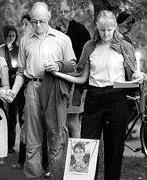
As Robert's parents, John and Iris, stood by, the young man's former junior high math teacher spoke for the family.
"Robert's family wish to say a heartfelt thank you to all of you standing here tonight," said Robert Wong.
"We're forever grateful to you, all of you."
Janet Hardy, a family friend who helped co-ordinate the volunteer search, added, "Thanks you guys, because we couldn't have done it without you."
Hardy said she learned a great deal about how to co-ordinate a search. She and some fellow searchers said they plan on putting together a package to help other families who go through the same struggle.
On August 23rd the medical examiner's office released its findings.
Using dental records, the identity of the body was confirmed as that of 20-year-old Robert Barrington Leigh.
Further details surrounding the death will not be released as it has been determined to be non-criminal in nature, the office said in a news release.
A book that Robert was working on with a University of Alberta professor will be completed and released in his honour.

On August 27th a private memorial service for Robert Barrington Leigh was held at the Strathcona Community Centre.
Friends and family gathered in the warmth of a late summer day and remembered a young man who wasn’t just a brilliant mathematician with a promising future, but a smiling, friendly well-rounded man with a love of theatre and adventure.
Those who gathered came to celebrate Barrington Leigh’s life, bearing flowers and sharing anecdotes. Many were barely out of their teens.
“Personally, I feel honoured to have been acquainted with such a talented person,” said a man who’d known Robert since the sixth grade.
Barrington Leigh was also remembered as a cross-country skier and avid outdoorsman.
“I have quite a great amount of respect for him. If you were well acquainted with him, you’d see he’s not just an intellectual in mathematics. He was quite adventurous,” said the friend.
“I remember he was always good natured,” said another. “He was really smart but never looked down on people. He was smiling, always.”
At the memorial it was revealed that police believe Robert Barrington Leigh took his own life by drowning.
His mother later confirmed the fact, telling media outside the Centre she wished she had seen the warning signs and that Robert had sought the help he needed.
In Toronto, another memorial took place at Yonge Street's Duke of Gloucester pub.
It was also announced that Robert would be immortalised with a University of Toronto Robert Barrington Leigh Scholarship Fund to be established in his name.
Details of the fund and a list of agencies which the family has chosen to receive donations in Robert's name can be found at www.findrobert.ca.
On August 29th, the Edmonton Sun published an article that seemed to attach a dark coda to the story of Robert Barrington Leigh.
Alan Flynn, 54, who found Robert's body, was quoted saying he hoped he was still entitled to the $5,000 reward posted by the family.
Flynn told the Sun that a Barrington Leigh family friend called him "disgusting" after he asked about the reward.
A woman who answered a phone call placed by the paper to the Barrington Leigh home said the family hasn't had a chance to discuss what they intended to do with the offer.
"I have a chance to do something good," Flynn said.
The boat operator said he wanted to donate the money to a cancer charity. Flynn's wife and sister are fighting cancer and his mother died of the disease.
"They offered the reward. They didn't say dead or alive," Flynn pointed out to the Sun.
"If it wasn't for me coming along, then he may have dislodged from where he was and he'd be gone forever."
While he hadn't tried to contact the family directly, Flynn wanted them to know he was still interested in the reward.
On September 1st the Sun again spoke with Alan Flynn and found that Barrington Leigh's finder had a change in fortune -- he lost his drainage inspection contract, or at least temporarily.
And his sudden burst of fame also cost him some peace of mind.
“It’s been a nightmare,” said Flynn.
The contracter said he was harangued by about a dozen angry callers who accused him of being “cold-hearted” and “a thief” for asking after the reward.
Flynn said the city also gave him similar treatment when they told him that “operations have been suspended” and his services weren’t needed.
A city spokesman confirmed that drainage-pipe inspections were "cancelled out of sensitivity" to the Barrington Leigh family.
“If the concern around the reward is still unresolved by (Sept. 11, when the next round of inspections is slated) we’ll expect to make other arrangements so that that inspection will go ahead,” the spokesman said.
While the city isn’t saying that Flynn is out of a job (“It’s only temporary”) it is left to speculation what role press coverage played in his change of luck.

One of the fascinating aspects of Barrington Leigh's disappearance was that Robert was no ordinary kid.
He was described often in the media as a "math whiz," a label he earned at the tender age of three.
A family story tells of how the toddler looked at ceiling lights in their home and realised he could count them quicker if he multiplied them rather than count each one individually.
By grade nine, Robert had two papers published in international journals, one describing a formula to minimize aroma loss in coffee shops.
"He's reading 400-level university material," said one of his mentors. "And in those journals, the authors are usually professors."
At 16 he helped defend Canada's honour at an International Mathematical Olympiad in Glasgow, Scotland.
Robert was one of six high school students from across Canada selected for the national team, having beaten more than 200,000 others in local, provincial and national math competitions.
Robert was ready to start his fourth year studying math and physics at the University of Toronto, and had just moved into an apartment with his girlfriend a month before he died.
Friends and colleagues described the likable young man as the kind of guy who memorised the value of pi (the ratio of a circle's circumference to its diameter) to 100 decimal points as a simple and unassuming lark.

Memorising pi is an obsession for some people.
The current unofficial world record is 83,431 decimal places, set by Japanese mental health counsellor Akira Haraguchi on July 2nd, 2005.
The official world record is 42,195, set by Hiroyuki Goto.
Despite supercomputer calculations that have determined over 1 trillion digits of pi , no pattern in the digits has ever been found. It is considered an infinite fraction.
Several web sites display pi calculated to one million and four million places.
pi day is celebrated every March 14th (approximating 3/14ths in American date format) which is also Einstein's birthday.
pi was also the 1998 debut film of director Darren Aronofsky, about a mathematician who searches for a key number that will unlock the universal patterns found in nature.
For more about this fascinating number, visit Wikipedia's extensive pi entry.
Robert Barrington Leigh's disappearance came nearly four months to the day after Sangeeta Khanna went missing after a trip to a Mill Woods bank.
Family of the 41-year-old single mother now suspect foul play is behind her disappearance.
Nearly 15 years before Barrington Leigh went missing another university student disappeared into Edmonton's river valley.
On January 23rd, 1992 23-year old St. Joseph's college student Dean Mortenson vanished and has not been seen since.
Hockey jerseys are hung from windows at the St. Joseph's residence every year on the anniversary of his disappearance.
A police spokesman defined "search manager" as an officer responsible for managing the assets (people and equipment) for the purpose of conducting a search by air, water or land.
The officer has received specialised training in search and rescue and works in a defined unit in the Disaster and Emergency Operations Planning (DEOPS) Section.
He or she is removed from their regular duties and is assigned to work in this area when the need arises. There are 13 officers with this type of specialised training [back to narrative].
